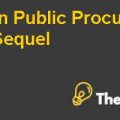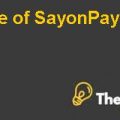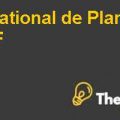ANALYSIS:
The analysis that has been done in the excel, it shows that the projected present value of the first project is around $105million, that is resulting from the evaluation of investment made in the manufacturing and distribution of the first project. Further analysis that has been made, shows the negative net present value after investing $10 million and the negative NPV is around $8.491million.
Further analysis has been made for the second generation phone in which Penelope as an investor had the choice to sell her company’s equipment after two years of business operations. When evaluating the first generation phone using the discounted cash flows approach that was not feasible for the evaluation of the first generation phone, Penelope considered the second alternative using the Black Scholles Model. In evaluating the value of the second-generation phone, Penelope considered this put option in the Black Scholles model that allows the investor to sell its company’s equipment in order to gain profit out of its operations.
In evaluating the second project, the gain on selling the equipment was taken as the exercise price and asset price was taken from the discounted cash flows. The cash flow amount that is the foregone value of the equipment is obtained from the sale of equipment. The put option resulted the value as $0.276 million, which incorporate the loss of around $9.724 million. This loss is higher than the loss evaluated in the above alternative.
On the other hand, the same Put option is evaluated using the Binomial Option Pricing Model approach which resulted in the Put value of $563 million. The value comes when the equipment of the company was sold after two years.
CONCLUSION:
From the analysis made above, it shows that the first alternative as investing in the first-generation phone is not feasible, as it is not giving the desired value as Penelope expected. Relatively, this alternative is showing the negative cash flows.
Moreover, if Penelope wanted to invest in the second-generation phone with the investment of $100 million than the value that comes from Black Scholes Model and Binomial Option Pricing Model is not reasonable as it is very low than the invested amount. Further, any invested amount would only be invested when there is acapital gain in investing the capital, but in this case, the return is very lower than the invested amount, which is around $1.7 million.
Further, both models such as Black Scholes and Binomial Option Pricing Model shows that the second project is feasible to continue as the value of the second project is Zero in both cases. In addition to the above analysis, it can be concluded that, the second option that is second-generation phone is not to be exercised as it had no value that could generate profit.
Company Valuation Case Solution
RECOMMENDATION:
It would be recommended that, if Penelope wanted to start her business than she must consider to manufacture the first generation phone at lower cost and the second-generation phone would only be launched when there is enough profit generated from the sales of first-generation phone but this profit maximization would only be achieved when Penelope effectively market its product.
Please see the Excel file for the calculation.
APPENDICES:
Exhibit 1:
|
DCF Analysis Amount in $000 |
||||||||
|
|
2001 |
2002 |
2003 |
2004 |
2005 |
2006 |
||
| Net Earnings |
($4,000) |
$0 |
$2,405 |
$2,285 |
($65) |
($900) |
||
| Add Depreciation |
$900 |
$900 |
$900 |
$900 |
$900 |
$900 |
||
| Less Investment in Working capital |
$1,500 |
$0 |
$0 |
$0 |
$0 |
($1,500) |
||
| Free Cash flows |
($4,600) |
$900 |
$3,305 |
$3,185 |
$835 |
$1,500 |
||
| PV at 17% |
$1,509 |
|||||||
| Investment Cost |
$10,000 |
|||||||
| NPV |
($8,491) |
|||||||
|
2001 |
||||||||
| Net Earnings |
($4,000) |
|||||||
| NPV |
($8,491) |
|||||||
Exhibit 3:
|
Second Project Valuation |
||||
|
Expected Value |
|
Probability |
Expected value |
|
| Cash flow Increase by 64.9% |
$2,489 |
0.5 |
$1,244 |
|
| Cash flow decrease by 39.3% |
$1,511 |
0.5 |
$755 |
|
| Expected Value |
$2,000 |
|||
| Expected Value that Justify Investment |
$101,000 |
|||
| Second Project Investment |
$100,000 |
|||
| NPV |
($98,000) |
|||
| NPV that Justify investment |
$1,000 |
|||
Exhibit 4:
|
Input Data |
|||
| Stock Price now (P) |
6515 |
||
| Exercise Price of Option (EX) |
4000 |
||
| Number of periods to Exercise in years (t) |
2 |
||
| Compounded Risk-Free Interest Rate (rf) |
10.00% |
||
| Standard Deviation (annualized s) |
50.00% |
||
|
Output Data |
|||
| Present Value of Exercise Price (PV(EX)) |
3274.92301 |
||
| s*t^.5 |
0.7071 |
||
| d1 |
1.3263 |
||
| d2 |
0.6192 |
||
| Delta N(d1) Normal Cumulative Density Function |
0.9076 |
||
| Bank Loan N(d2)*PV(EX) |
2397.5541 |
||
| Value of Call |
3516 |
||
| Value of Put | 276 | ||
|
First Project with put option (Abandonment by selling equipment for 4 million) |
|||
| Exercise Price | 4,000 | ||
| Asset Price | 6,515 | ||
| Standard Deviation |
50% |
||
| Value of Put Option | 276 | ||
| Investment Cost | 10,000 | ||
| NPV | (9,724) | ||
Exhibit 5:
|
Binominal Option Pricing for First Project |
|||
|
First Project |
|||
|
Ingredients |
|||
| Stock Price S0 |
6515 |
||
| Exercise Price X |
4000 |
||
| Interest Rate r |
0.1 |
||
| Volatility |
0.5 |
||
| Time to Maturity |
2 |
||
| Number of Steps |
5 |
||
| Dividend Yield |
0 |
||
|
Black Scholes analytical solution |
|||
|
d1 |
1.326267651 |
||
|
d2 |
0.619160869 |
||
|
nd1 |
0.907624471 |
||
|
nd2 |
0.732094806 |
||
|
n_dash_d1 |
0.165558367 |
||
.....................................
This is just a sample partial case solution. Please place the order on the website to order your own originally done case solution.












